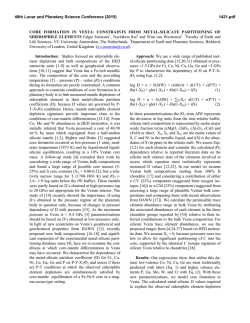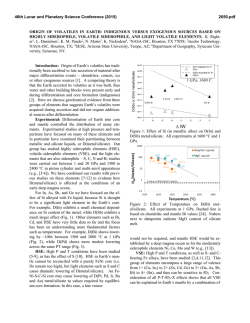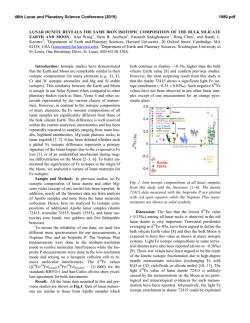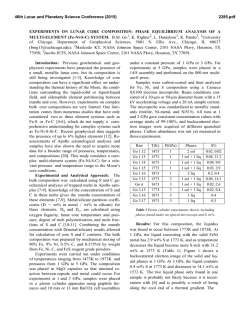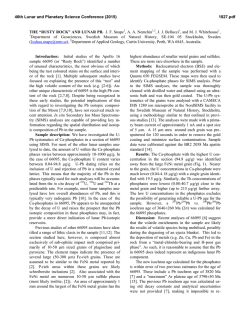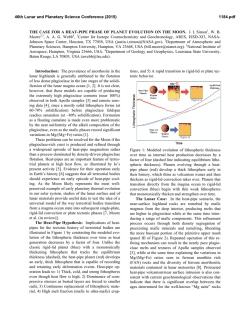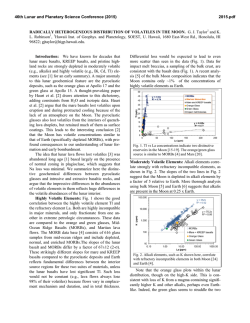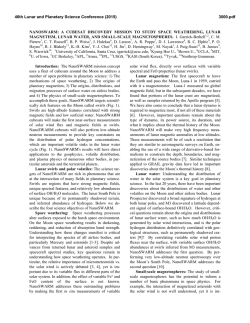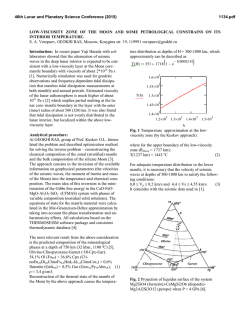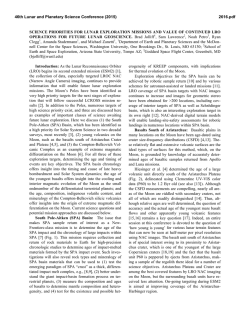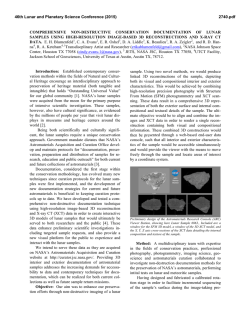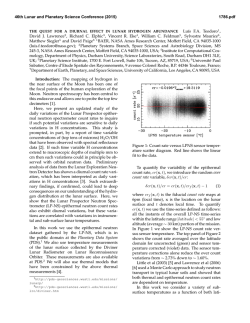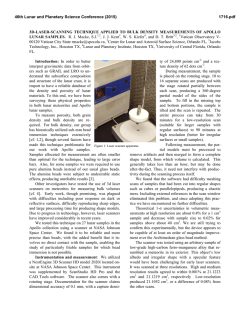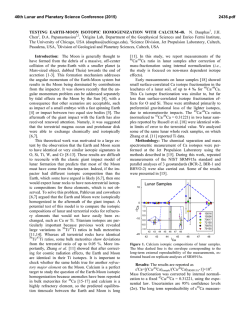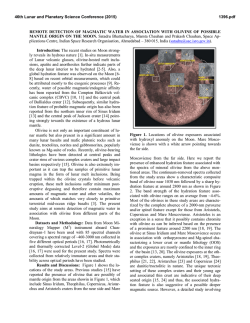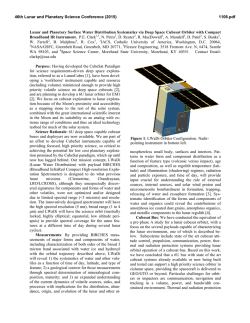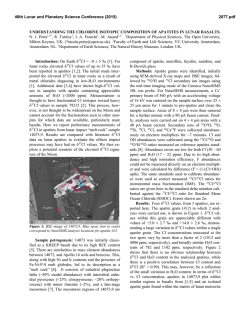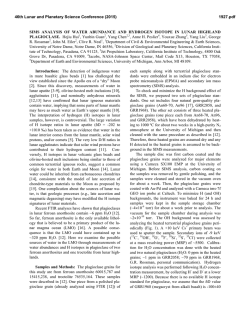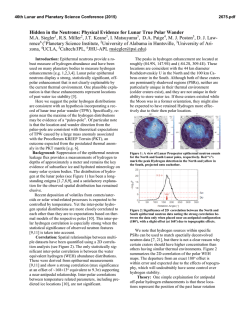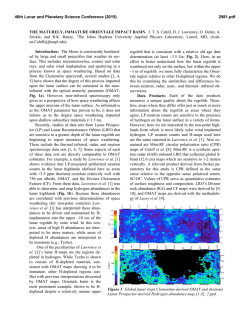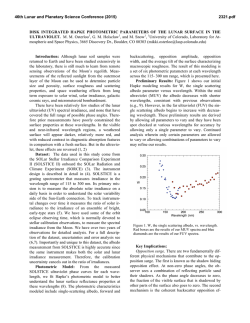
new geochemical models of core formation in the - USRA
46th Lunar and Planetary Science Conference (2015) 1490.pdf NEW GEOCHEMICAL MODELS OF CORE FORMATION IN THE MOON FROM METAL-SILICATE PARTITIONING OF 14 SIDEROPHILE AND CHALCOPHILE ELEMENTS Edgar Steenstra1, Nachiketa Rai2 and Wim van Westrenen1. 1Faculty of Earth and Life Sciences, VU University Amsterdam, The Netherlands, 2 Department of Earth and Planetary Sciences, Birkbeck University of London, United Kingdom ([email protected]). Introduction: It is now well established that the Moon possesses a Fe-rich metallic core, based on siderophile element depletions [1] and re-analysis of Apollo lunar seismograms [2]. Knowledge of the conditions at which lunar core-mantle differentiation occurred is of great importance for models of lunar formation and early thermal evolution. Previous studies have shown that the abundance pattern of siderophile elements in the lunar mantle provides important clues on the conditions at which core formation occurred, because their metal-silicate partition coefficients (D) are governed by pressure (P) – temperature (T) – composition (X) and oxygen fugacity (fO2) [1,3,4]. Recently Rai and Van Westrenen [1] showed that the lunar mantle abundances of P, V, Cr, Co, Ni, Mo, W can be reconciled with core-mantle equilibration in a deep magma ocean (4.5±0.5 GPa) at high temperature (2200 K), in the presence of a Fe-rich metallic core containing at least 6 wt.% S. Besides Fe and S, Ni is another major element thought to be present in the lunar core, with estimates between 5 to 30 wt. % [5-7]. It has been shown that D can be strongly dependent on silicate melt and/or metallic liquid composition [8-11]. However, the effects of S and Ni on D still poorly quantified for many elements. Recent publication of many Sbearing metal-silicate partitioning experiments for a wide range of elements and conditions [12-15] prompted us to reassess the role of S and Ni on D in greater detail and re-examine if the lunar mantle depletions of a wider range of 14 siderophile and chalcophile elements (P, V, Cr, Co, Ni, Ga, Ge, Se, Mo, Cd, Sn, Te, W, Pb) can simultaneously be satisfied by metalsilicate equilibration of a Fe-Ni-S lunar core in a magma ocean-type setting. Approach: We extended the approach of [1] by incorporating recently published experimental data to the database of published metal-silicate partitioning data from a wide range of studies [12-26] obtained at pressures between 1 atm – 5 GPa at lunar relevant conditions to quantitatively assess the dependency of D on P-T-X-fO2 using Eqs. (1,2): log D = a + b(∆IW) + c(nbo/t) + d(1/T) + e(P/T) + fln(1-XS) + gln(1-XC) + hln(1-XNi) + i(S) (1) log D = a + b(∆IW) + ∑ciXi+ d(1/T) + e(P/T) + fln(1-XS) + gln(1-XC) + hln(1-XNi) + i(S) (2) In these equations, fO2 is represented by ∆IW, which defines the deviation in log units from the iron-wüstite buffer, silicate melt composition is represented by molar major oxide fraction terms (cMgO, cSiO2, cAl2O3, cCaO and cFeO) or nbo/t, XS, XC and XNi are the molar fractions of S, C and Ni in the metallic liquid, and i(S) is the abundance of S (in ppm) in the silicate melt. We assessed the reliability of each parameterization by comparing the resulting fO2 dependency term with reported literature values of the valence state in the silicate melt of the element in question [8,13,27]. We combined our newly derived parameterizations with (a) proposed bulk Moon and bulk silicate Moon minor element abundances from the works of [4,5,8,28-34], (b) bulk Moon major element compositions and (c) a core mass (2.5 wt.%) from [1] to model core-mantle differentiation in the Moon. For bulk Moon abundances of S, Se, Cd, Sn, Te, Pb we use bulk silicate Earth values proposed by [34]. We allow P to vary between 0-5 GPa and assume XC = 0, because for elements Te, Se, Cd and Pb no carbon-bearing experiments are currently available in the literature. Results: Linear regression results show that Eq. (2) yields the best results for 10 elements (P, V, Cr, Ga, Se, Mo, Cd, Te, W, Pb) while partitioning data for the other 4 (Ge, Co, Ni, Sn) are better predicted with Eq. (1). For 10 elements we found a statistically significant (p <0.05) dependency for XS (V, Cr, Co, Ni, Ga, Ge, Se, Cd, Te, Pb), for 8 elements a statistically significant dependency for i(S) (P, Cr, Co, Ni, Se, Cd, Te, Pb) and for 5 elements (Co, Ga, Ge, Se, W) we found a statistically significant XNi term. Preliminary modeling (Figure 1) suggests the estimated depletions of all elements considered here can be simultaneously satisfied by metal-silicate equilibration of a sulfur rich (XS ≈ 0.18, corresponding to approximately 11 wt. %) and nickel bearing (XNi ≈ 0.03) metallic core at fairly reducing conditions (∆IW ≈ 2.15), high temperature (T ≈ 2650 K) and high pressure (P ≈ 4 GPa, close to the present-day core-mantle boundary pressure). The equilibration pressure is often considered to represent the depth of a magma ocean present during core formation. These results thus point 46th Lunar and Planetary Science Conference (2015) to the Moon being essentially fully molten during core formation. These results are in general agreement with the recent study of [1], but suggests a higher core sulfur content for the Moon as well as significantly higher temperatures during lunar core formation. The high core S content could explain the proposed current molten state of the outer core and the prolonged existence of a lunar core dynamo [35,36]. It was recently suggested that the evolution of a lunar core dynamo may be best explained by transition from inner core growth to a “Fe-snow’’ regime, which is only feasible with initial sulfur contents of 8-9±1 wt.% [36,37], close to our modeled value. It also falls below the upper boundary of sulfur content of the lunar core (<12 wt.%) to be compatible with the crystallization and presence of a lunar inner core [2,37]. Figure 1. Estimated log D (grey symbols) that are required to satisfy the siderophile and chalcophile element depletions of the lunar mantle and modeled log D (white symbols) at ∆IW = -2.15, P ≈ 4 GPa, T =2650 K, XS ≈ 0.18, XNi ≈ 0.03, XC = 0 and i(S) = 0. Outlook: Future modeling will attempt to incorporate Cs, In, As, Sb and Tl data when their D’s are sufficiently quantified. Experiments are currently performed to further explore the effect of pressure, sulfur and carbon on the partitioning of chalcophile and siderophile elements, including elements that may shed light on the volatile history of the early Moon. Finally, we note that several lines of evidence now suggest that the lunar interior contains significant amounts of water [38]. The effect of water on metal-silicate partitioning is virtually unconstrained at present, and the effect of water on the metal-silicate partitioning of essentially all siderophile and chalcophile elements should be explored [39,40]. 1490.pdf References: [1] Rai and van Westrenen (2014) EPSL 388, 343-352. [2] Weber et al. (2011) Science 331, 309-312. [3] Rai and van Westrenen (2013) JGRP 118, 1195-1203. [4] Righter and Drake (1996) Icarus 124, 513-529. [5] Righter (2002) Icarus 158, 1-13. [6] Newsom (1989) LPSC XX, 785. [7] Kantor et al. (2006) Doklady Physics 51, 584-587. [8] Walter et al. (2000) In Origin of the Earth and Moon, U of A press, Tucson 265-289. [9] Righter (2003) Ann. Rev. Earth Plan. Sci. 31, 135-174. [10] Jana and Walker (1997) GCA 61, 5255-5277. [11] Jana and Walker (1997) EPSL 150, 463-472. [12] Ballhaus et al. (2013) EPSL 362, 237-245. [13] Kiseeva and Wood (2013) EPSL 383, 68-81. [14] Mungall and Brenan (2014) GCA 125, 265-289. [15] Wood et al. (2014) GCA 145, 248-267. [16] Peach and Mathez (1993) GCA 57, 3013-3021. [17] Thibault and Walter (1995) GCA 59, 991-1002. [18] Gaetani and Grove (1997) GCA 61, 1829-1846. [19] Righter and Drake (2000) GCA 64, 3581-3597. [20] Chabot and Agee (2003) GCA 67, 2077-2091. [21] Kegler et al. (2008) EPSL 236, 78-95. [22] Righter et al. (2010) EPSL 291, 1-9. [23] Righter et al. (2011) EPSL 304, 379-388. [24] Siebert et al. (2011) GCA 75, 1451-1489. [25] Wade et al. (2012) GCA 85, 58-74. [26] Righter (2011) EPSL 304, 158-167. [27] Righter et al. (2006) Am. Mineral. 91, 1643-1656. [28] Delano (1986) In Origin of the Moon, LPI, Houston 231-248. [29] Drake (1987) JGR 92, E377-E386. [30] Newsom and Taylor (1989) Nature 338, 29-34. [31] O’Neill (1991) GCA 55, 1135-1157. [32] Jones and Palme (2000) In Origin of the Earth and Moon, U of A press, Tucson 197-216. [33] Hauri et al. (2015) EPSL 409, 252-264. [34] McDonough and Sun (1995) CG 120, 223-253. [35] Stegman et al. (2003) Nature 421, 143-146. [36] Rückriemen et al. (2014) LPSC XLV, #2546. [37] Laneuville et al. (2014) EPSL 401, 251260. [38] Hauri et al. (2011) Science 333, 213-215. [39] Righter and Drake (1999) EPSL 171, 383-399. [40] Steenstra et al. (2014) European Lunar Symposium, 48-49.
© Copyright 2024
